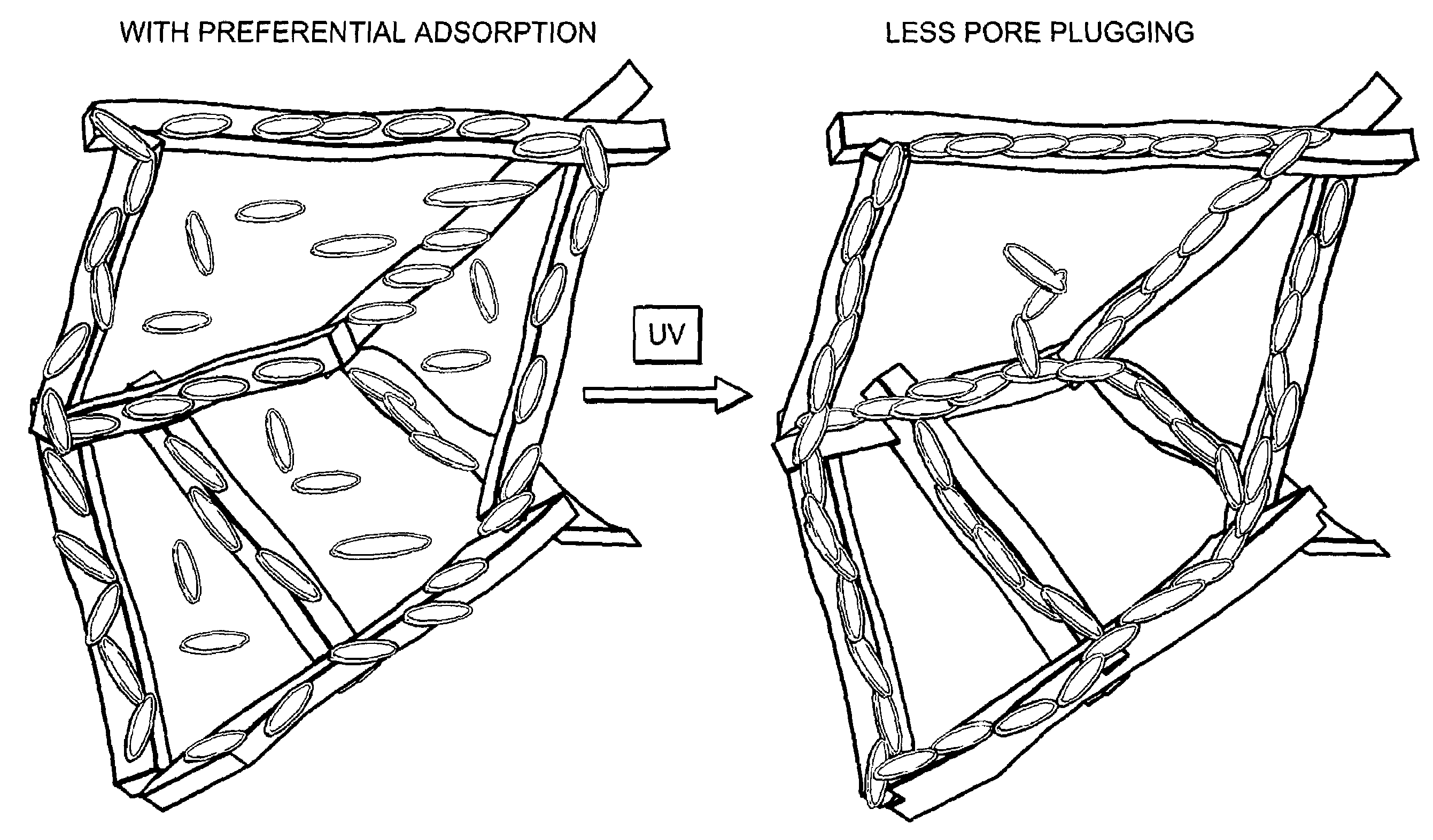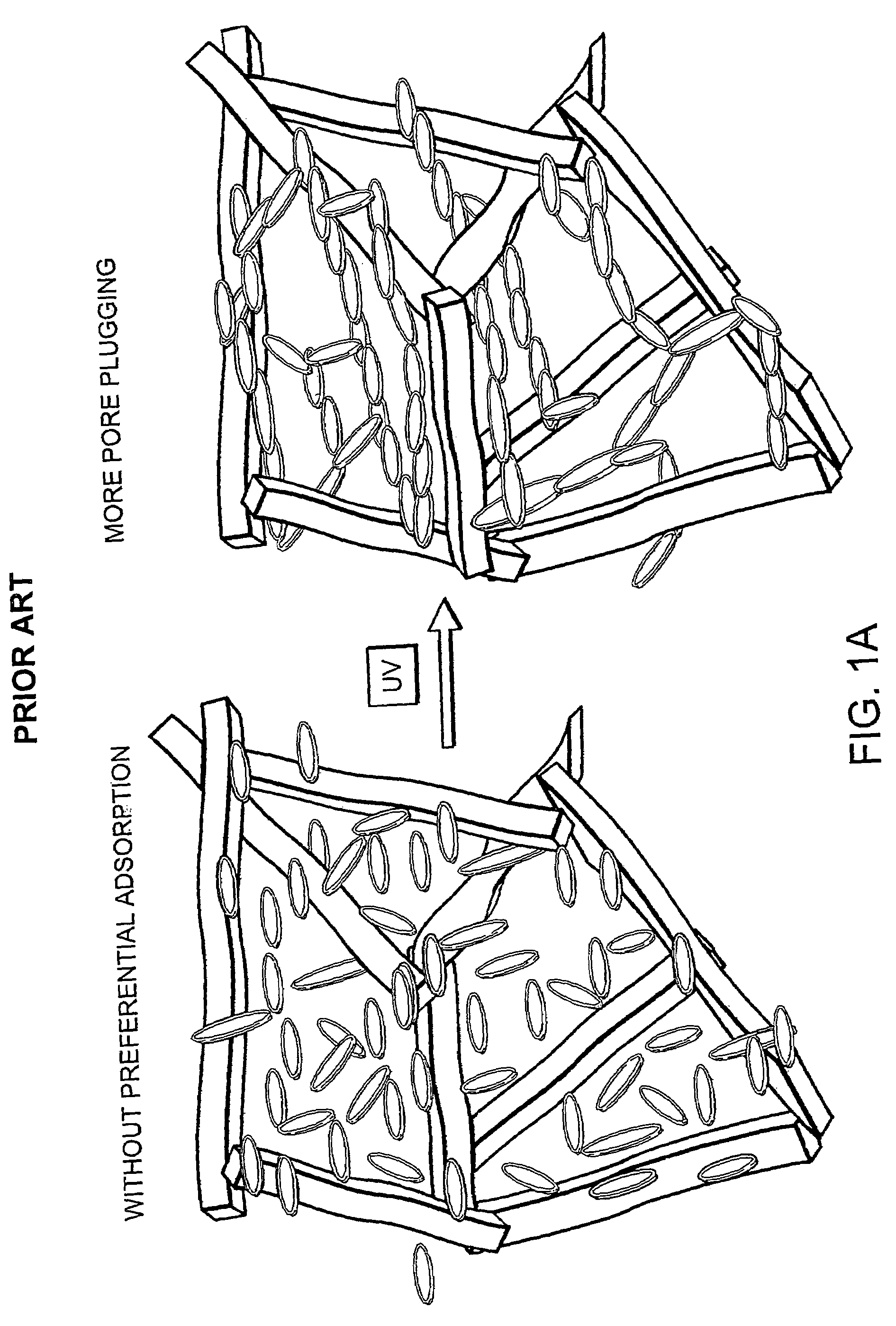Porous composite membrane and method for making the same
a composite membrane and porous technology, applied in the field of porous composite membranes, can solve the problems of membranes so coated that cannot be subjected to repeated wetting and drying procedures without loss, undesirable, and unsuitable for applications, and achieve the effect of maximizing the amount of surface-modifying molecules deposited
- Summary
- Abstract
- Description
- Claims
- Application Information
AI Technical Summary
Benefits of technology
Problems solved by technology
Method used
Image
Examples
example 1
[0082]A hydrophobic PVDF microporous membrane, having an average pore size of 0.45 micron and average thickness of 120 microns, was rendered hydrophilic by treating with a reagent bath containing a difunctional acrylate monomer and a photoinitiator in 50 / 50 IPA water solvent mixture. The difunctional acrylate monomer was ethoxylated (30) bisphenol A diacrylate (Sartomer CD 9038) and the photoinitiator was 1-[4-(2-Hydroxy)-phenyl]-2-hydroxy-2-methyl-1-propane-1-one (Ciba Irgacure 2959). Three membrane samples were treated in a flow through mode while another 3 samples were treated in a passive immersion mode. The treated membranes were UV irradiated, washed and dried. The concentration used for the treatments and the wettability of the resulting membranes is listed in the following table. The total treatment time was equal to 5 minutes in both cases.
[0083]The results demonstrated an instant wetting of the flow-through treated membranes versus an uneven wetting, with a lot of phobic s...
example 2
[0085]A polyvinylidene difluoride (PVDF) microporous membrane, having an average pore size of 0.2 micron and average thickness of 120 microns, is treated to produce a hydrophilic surface.
[0086]One set of 2 samples was treated in a flow-through mode with the reagent bath containing 1% of ethoxylated (30) bisphenol A diacrylate (Sartomer CD 9038) and 0.5% 1-[4-(2-Hydroxy)-phenyl]-2-hydroxy-2-methyl-1-propane-1-one (Ciba Irgacure 2959).
[0087]A second set of samples was treated in a flow-through mode with the reagent bath containing 1% of polyethylene glycol (400) diacrylate (Sartomer SR 344) and 0.5% 1-[4-(2-Hydroxy)-phenyl]-2-hydroxy-2-methyl-1-propane-1-one (Ciba Irgacure 2959).
[0088]Ethoxylated (30) bisphenol A diacrylate (Sartomer CD 9038) has a hydrophobic anchor and is capable of preferential adsorption on phobic substrates, while polyethylene glycol (400) diacrylate (Sartomer SR 344) is a totally hydrophilic molecule, and is not capable of a significant, preferential adsorption ...
example 3
[0092]A PVDF microporous membrane, having an average pore size of 0.2 microns and average thickness of 120 microns, was treated to produce a hydrophilic surface. Two samples were treated in a flow through mode with the reagent bath containing 2% of ethoxylated (30) bisphenol A diacrylate (Sartomer CD 9038) and 0.5% Ciba Irgacure 2959 in 70 / 30 water / IPA solvent. The third sample was used as an untreated control. The treated membranes were UV irradiated, washed and dried.
[0093]The results after washing and drying of the membranes demonstrated an instant wetting of the flow-through treated membranes. The performance characteristics revealed no differences between treated and non-treated membranes.
[0094]
Wettabilityafter dryingIPAat 90° C.,bubblenumbercompositiontreatment18 hourspointControlNANAphobic24112% cd9038; 0.5% IrgacureFlow-wet242959; 70 / 30 H2O / IPAthrough122% cd9038; 0.5% IrgacureFlow-wet242959; 70 / 30 H2O / IPAthrough
PUM
| Property | Measurement | Unit |
|---|---|---|
| pore size | aaaaa | aaaaa |
| pore size | aaaaa | aaaaa |
| pore size | aaaaa | aaaaa |
Abstract
Description
Claims
Application Information
 Login to View More
Login to View More - R&D
- Intellectual Property
- Life Sciences
- Materials
- Tech Scout
- Unparalleled Data Quality
- Higher Quality Content
- 60% Fewer Hallucinations
Browse by: Latest US Patents, China's latest patents, Technical Efficacy Thesaurus, Application Domain, Technology Topic, Popular Technical Reports.
© 2025 PatSnap. All rights reserved.Legal|Privacy policy|Modern Slavery Act Transparency Statement|Sitemap|About US| Contact US: help@patsnap.com



